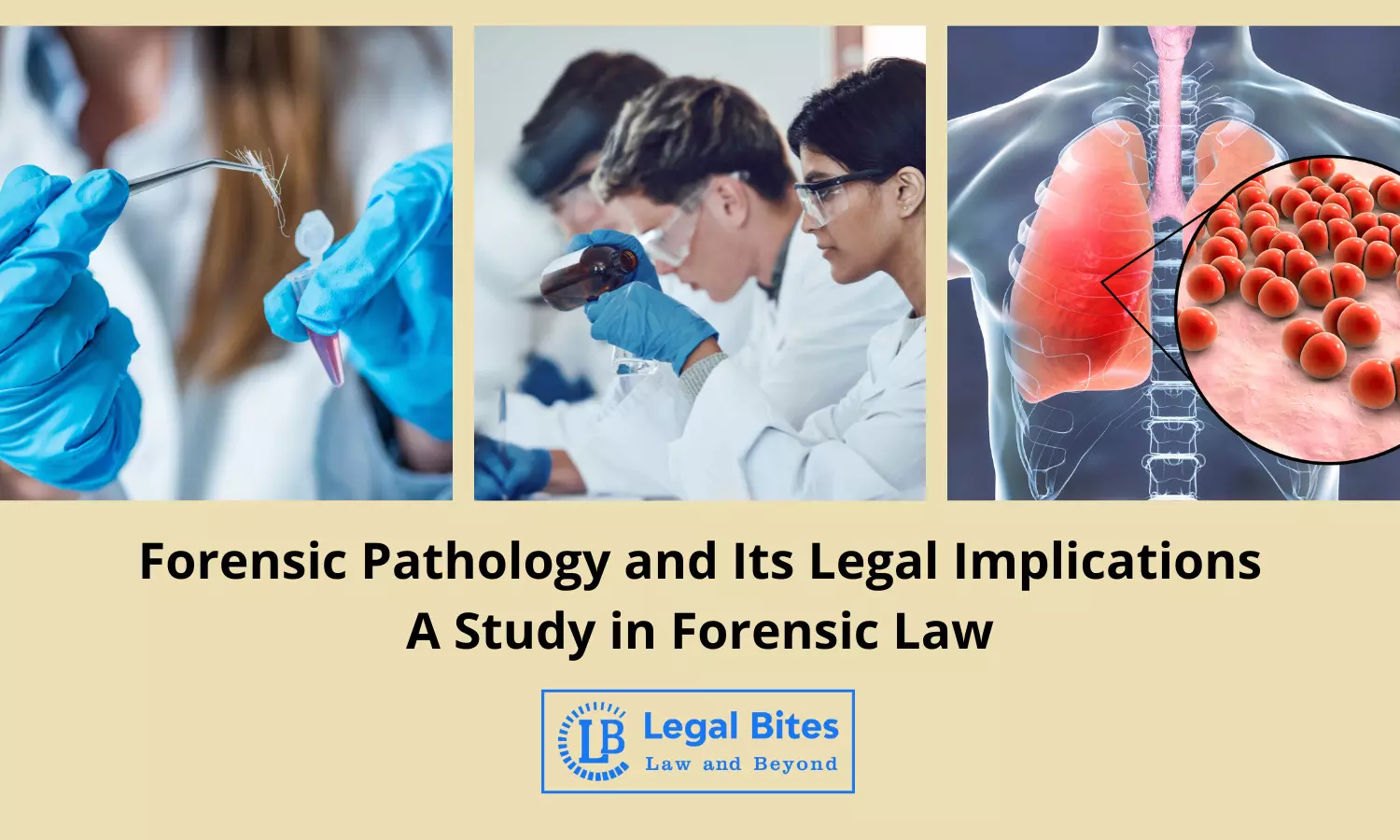Forensic Pathology and Its Legal Implications: A Study in Forensic Law
The article 'Forensic Pathology and Its Legal Implications: A Study in Forensic Law' discusses at length the concept of forensic pathology, its meaning and types.

The article 'Forensic Pathology and Its Legal Implications: A Study in Forensic Law' discusses at length the concept of ‘forensic pathology’, its meaning and types.Forensic Pathology refers to that branch of science which assists in the courtrooms by presenting evidence that helps in convicting or acquitting the accused. The process termed forensic pathology comprises the determination of the cause of death of a corpse by examining it. The person who conducts the process is...
The article 'Forensic Pathology and Its Legal Implications: A Study in Forensic Law' discusses at length the concept of ‘forensic pathology’, its meaning and types.
Forensic Pathology refers to that branch of science which assists in the courtrooms by presenting evidence that helps in convicting or acquitting the accused.
The process termed forensic pathology comprises the determination of the cause of death of a corpse by examining it. The person who conducts the process is often referred to as a forensic pathologist or a medical examiner. The process is referred to as post-mortem and is usually a part and parcel of the investigation of criminal law cases and in some instances civil law cases as well. Identity confirmation is also often asked to be done by the medical examiners who are thereby involved in the process.
The juxtaposition of these two fields of subject medical and paramedical knowledge to the imparting of justice equitably is known as forensic science. ‘Forensic’ is understood as forums that are applied in the court of law to ascertain the guilt or innocence of the accused person which would thereby ultimately provide justice to the public at large. Medical science is thus used in cases of criminal law such as murder, sexual offences, poisoning and so on.
Understanding Forensic Pathology
Forensic medicine or forensic pathology can be understood to mean ‘legal medicine’. This study involves an interdisciplinary study of scientific knowledge with legal principles. Objective data needed for usage in the judicial system is extracted from the results derived by forensic pathology. Medical evidence is thus gathered to perform the examination and reach those results. In simple words, it can be stated that:
“Applying science to statutes enacted in criminal justice by law enforcement agencies.”
Salient features of forensic pathology can be understood as the following:
- Application of science in legal problems is referred to as forensic pathology.
- Forensic pathology comprises of collection and integration of data which is collected from several sources which helps further in arriving at the cause and manner of death.
- The presentation of data must be done in a manner that is easy to comprehend in the courtroom of law.
- While interpreting such evidence, it is the duty of the forensic pathologist that he must remain impartial to arrive at results that are true and fair in all their means.
Types of Forensic Pathology
The two main branches of forensic pathology that are commonly put to use are:
i. Anatomical Pathology- This refers to the analysis and examination of the body tissues to answer questions such as cause of death, damage caused to the different body parts due to the impact of the murder weapon, possible murder weapon and its description.
ii. Clinical Pathology- Clinical pathology is used to examine the body fluids. This is the process that is put to use, especially in circumstances where the examination pertains to ascertaining the presence of certain substances in the body fluids for further ascertaining the cause of death or injury that is in legal question.
Forensic Pathology in India: Legislative Framework
Back in the 19th century, forensic pathology had started being used in India as a part of forensic science. The first-ever legislation that gave validity to forensic pathology in India was the Indian Evidence Act, 1872. This law in general permitted the admissibility of evidence in the courtroom that was scientific and also included medical examination results as evidence in the courts. As of today, several legislations govern the use of forensic science in India. They include the Code of Criminal Procedure, Indian Evidence Act, Narcotic Drugs and Psychotropic Substances Act. The said legislation is responsible for regulating the collection, preservation, analysis and presentation of forensic evidence in the courts.
Cases involving Forensic Pathology
Following are some of the cases that used forensic pathology for decoding the case at hand and thus reinforced the importance of forensic pathology in India:
1. Vasu v. Santha,1975 Ker LT 533
This is an important case because the following standards concerning DNA tests were reiterated by the court. The same are as follows:
i. Blood tests cannot be ordered by Indian Courts as a matter of practice.
ii. Forceful submission of blood samples cannot be asked to be made as it would be against the law.
iii. ‘Presumption’ under Section 112 of the Evidence Act would require the husband to state that there was no access.
2. Tandoor Murder Case (Sushil Sharma v. State of N.C.T. of Delhi, CriminalAppeal No. 693 of 2007)
The first ever Indian case which was solved with the help of forensics was the Tandoor murder case. As the body had been burnt in the tandoor, forensic pathology helped in ascertaining the victim’s identity and proving the reason for death to be injuries caused before the body had been set to burn in the tandoor.
Conclusion
Investigations in certain criminal cases involve the usage of forensic pathology as the same helps in ascertaining the answers to questions relating to the cause of death etc. as has been discussed above. The various techniques that are used in this regard are important as they lead to quick and reliable adjudication of the cases at hand. It is thus, imperative for this field of science to grow and diversify to make justice administration more efficient. Ultimately, the question is not merely about prosecuting and subsequently convicting the one at fault but also about acquitting the person, if any innocent has been wrongly implicated. Thus, the level of accuracy required for this must be high and the same can be done if more importance is given to this field of study to boost research and development in this regard.
References
[1] Niharika Sangwan, Forensic law and jurisprudence, Available Here
[2] Legal and Ethical Considerations in Forensic Pathology Research, Available Here
[3] Ajay Gautam, Forensic Law and Forensic Science in India, Available Here
Important Links

Snehil Sharma
Snehil Sharma is an advocate with an LL.M specializing in Business Law. He is a legal research aficionado and is actively indulged in legal content creation. His forte is researching on contemporary legal issues.
